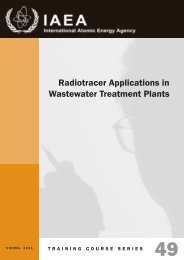Second Environmental Performance Review of Albania
Second Environmental Performance Review of Albania
Second Environmental Performance Review of Albania
You also want an ePaper? Increase the reach of your titles
YUMPU automatically turns print PDFs into web optimized ePapers that Google loves.
Chapter 8: Forestry, biodiversity and protected areas121In 2011, MoEFWA drafted the DCM on the Rulesand Procedures for the Designation <strong>of</strong> SpeciallyProtected Areas, aimed at full transposition <strong>of</strong>annexes III and IV to the Habitats Directive, and theDCM on the Designation <strong>of</strong> the Natural EcosystemKorab–Koritnik as a Managed Nature Reserve,(together with the required proclamation study anddigital map). Their approval was expected in 2012.The management plan for Butrinti National Park andfor Kune–Vain Managed Nature Reserve wasapproved in 2011.Future plans resulting from the national strategiesrelated to protected areas include the implementation<strong>of</strong> the Emerald network <strong>of</strong> ASCIs as a contribution toPEEN and PEBLDS, and review <strong>of</strong> the nationalPoWPA in light <strong>of</strong> new developments from theCBD’s COP 10 held in Nagoya, Japan, in October2010.Institutional frameworkThe institutional framework for protected areadesignation and management has gone throughseveral changes in recent years. Initially, theresponsibilities for protected areas were assigned tothe Ministry <strong>of</strong> Environment, but the Ministry <strong>of</strong>Agriculture and Food (through its GeneralDirectorate for Forests and Pastures) retainedresponsibility for protected areas administration.Such unclear division <strong>of</strong> responsibilities between thetwo ministries to a large extent prevented theeffective implementation <strong>of</strong> the national natureconservation policy defined in the BiodiversityStrategy and Action Plan for the period 2000-2015.In 2005, the competencies for protected areas weretransferred to MoEFWA, as more relevant for natureprotection issues. Protected areas are currentlyamong the responsibilities <strong>of</strong> MoEFWA’s GDEP,namely its two technical directorates, the DB and theDFP.The DB is responsible for the protection <strong>of</strong> naturalhabitats and ecosystems, protected areas and naturemonuments, and for conservation <strong>of</strong> wild fauna andflora species. Its Sector for Protected Areas andNational Parks employs three specialists. The role <strong>of</strong>the DB is limited to drafting legislation related to theprotected areas and policies towards the developmentand strengthening <strong>of</strong> the national ecological network,developing the Emerald network and Ramsar sitenetworks, and identifying IBAs and IPAs as well aspotential SPAs and SACs.The DFP is responsible for the administration andmanagement <strong>of</strong> protected areas. The DFP executingagencies operate in all 12 regions, and the DFSDsmanage national parks and other protected areasinvolving forestry land. The law enforcement andcontrol functions in protected areas are performed bythe Forestry Police.Pursuant to the 2005 Government Decision on theProtected Areas Committee, all protected areas incategories II and IV should have their localmanagement committees, as participatory structuresinvolving local stakeholders (e.g. local governmentrepresentatives, communities, landowners, NGOs andentrepreneurs) in site planning and management.Such management committees have so far beenestablished for some national parks. Protected areasare designated by a DCM, while the roles <strong>of</strong>MoEFWA include preparation <strong>of</strong> the requireddocumentation for any new proposal, including theGIS map and the detailed functional zoning patternproposed for the areaThe fees collected by the respective communes, andrevenues gained from tourist and recreational uses <strong>of</strong>the protected area, usually neither contribute to thebudget for nature protective measures to be applied inthe area, nor compensate for the damage to natureresulting from intensive recreational uses, which arenot always compatible with the main objectives <strong>of</strong>the protected area designation.In very few cases where some basic facilities (e.g.buildings planned for visitor centres) are owned bythe protected area administration, they remain eithernot fully equipped to perform such functions, orcompletely unused, due to budgetary constraints.This results in a lack <strong>of</strong> sustainable and stablefunding (or project external funding) for theircompletion, maintenance and operations.8.5 Conclusions and recommendationsThe ongoing transfer <strong>of</strong> the ownership, rights to use,and responsibilities for the management <strong>of</strong> theplanned 60 per cent <strong>of</strong> <strong>Albania</strong>’s forests and pasturesto local communes would require continuous supportand capacity-building for the communal forestowners.This change has already had an impact on theinstitutional structures and staff <strong>of</strong> the forestryservices directorates, while other potential effects <strong>of</strong>the above change, if improperly managed, on thestate <strong>of</strong> forests (both State and communally owned)can hardly be predicted.
















